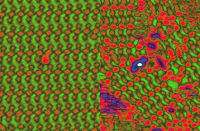Molecules wrestle for supremacy in creation of superstructures

(PhysOrg.com) -- Research at the University of Liverpool has found how mirror-image molecules gain control over each other and dictate the physical state of superstructures.
The research team studied 'chiral' or 'different-handed' molecules which are distinguishable by their inability to be superimposed onto their mirror image. Such molecules are common - proteins use just one mirror form of amino acids and DNA, one form of sugars. Chirality leads to profound differences in the way a molecule functions - for example, drugs such as thalidomide can have positive effects on a patient but can prove harmful in their mirror image form.
Molecules can also assemble in large numbers and form 'superstructures' such as snowflakes which are created from large numbers of water molecules. When chiral molecules assemble they can create 'handed' superstructures; for example left-handed molecules can assemble together to make a left-handed superstructure. The Liverpool team studied this process in detail by assembling molecules at flat surfaces and using imaging techniques to map the formation of superstructures at nanoscale level.
Before now, scientists have not known whether, in systems containing both left-handed and right-handed molecules, one mirror-form of a molecule could take supremacy over its opposite number in the creation of superstructures, dictating their physical state and chemical and biological properties.
The research found that when equal numbers of mirror-molecules are present at the surface, they organise into separate left and right-handed superstructures, each with distinctly different properties. Crucially, a small imbalance in the population leads to a dramatic difference and only the molecules in the majority assemble into its superstructure, while the minority is left disordered at the surface and unable to create advanced molecular matter.
Professor Rasmita Raval from the University's Surface Science Research Centre said: "We were surprised at these results. All perceived wisdom was that the left and right-handed molecules would simply create their respective superstructures in quantities that reflected the molecular ratio - that is, we would observe proportional representation. Instead, what we obtained was a kind of 'molecular democracy' that worked on a 'first-past-the-post' system where the majority population wrested chiral control of the superstructures and the minority was left disorganised."
Theoretical modelling carried out by the University of Eindhoven in the Netherlands found that this behaviour arises from the effects of entropy, or disorder, which leads the chiral molecules in the majority to preferentially organise into their superstructure.
The work has important implications in the pharmaceuticals industry and could lead to the development of surface processes to enable separation of drugs and products that are currently difficult to purify. The research also introduces the possibility that assembly processes at surfaces may naturally have led to the evolution of proteins and DNA - the molecules of life - containing just one mirror form of amino acids and sugars.
The research, in collaboration with the University of Eindhoven, is published in Nature Chemistry.
Source: University of Liverpool (news : web)


















